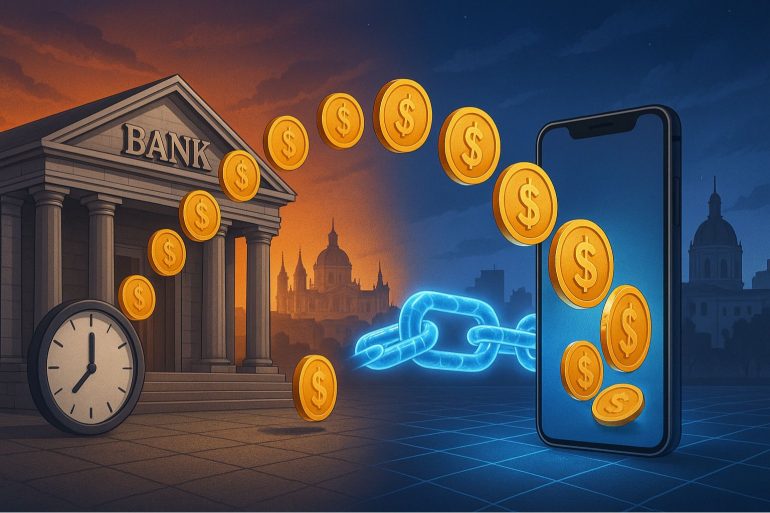Paraguay received an estimated US$878 million in remittances in 2024. That figure equals about 2% of GDP, which may sound modest at the national level, but is crucial for thousands of Paraguayan households. For families, these transfers help pay rent, school fees, and everyday expenses. The majority of flows come from relatives in Spain, Argentina, and the United States. This article is the second in a short The Asunción Times stablecoin series, looking at how these transfers work today, what they cost, and whether digital dollars can make a difference.
The cost of sending money home
A remittance is a cross-border money transfer, usually from a worker abroad to their family at home. These transfers almost always involve fees. Providers charge a visible transfer fee, and they also build in a less visible cost by offering weaker exchange rates when converting currencies.
Globally, sending US$200 costs on average about 6% of the amount sent. For Latin American corridors, costs often range from 6 to 8%. This means that if someone sends US$200 to Paraguay, their family may receive only about US$185 after fees, and exchange-rate margins.
Digital remittance apps, which work through smartphones, have narrowed these costs somewhat, often closer to 4–5%. Still, traditional providers such as banks or money transfer offices remain common, especially in rural areas.
Average cost of sending US$200 to Paraguay (2024)
| Method | Approximate Cost | Typical Speed | Limitation |
| Bank wire or cash transfer | ~7.4% (USD 15) | 1–3 days | High fees, FX markup |
| Digital remittance app | ~4–5% (USD 8–10) | Same day | Provider access, FX spread |
| Stablecoin transfer (USDT/USDC) | ~0.5–3% (few cents–few USD) | Minutes | Internet needed, cash-out depends on services |
Sources: World Bank Remittance Prices Worldwide (2024), Mastercard “Future of Remittances” report (2024), Coinbase report (2024).
Where stablecoins fit in
Stablecoins, introduced in the first article of this article series by The Asunción Times, are digital tokens designed to track a reference asset such as the US dollar. A worker in Spain or the United States can buy stablecoins, transfer them to a relative in Paraguay within minutes, and the recipient can decide what to do next.
The options are to convert stablecoins into guaraníes through an exchange, or to spend them directly with crypto-linked cards that convert at the point of sale. Both Visa and Mastercard now support programs that allow partners to issue these cards, and some popular examples include the Bybit Card and CryptoCom Card.
The cost depends heavily on the network. On blockchains like Solana or Tron, transaction fees are often just a few cents. On Ethereum, costs can be several dollars during busy periods. Transfers through centralised exchanges, like Binance or Kraken, may add their own withdrawal fees.
This flexibility is what makes stablecoins attractive for remittances. They offer the possibility of near-instant transfers, exposure to US dollar value, and in some cases the ability to spend directly without converting to local cash.
Benefits, and challenges in practice
For families in Paraguay, stablecoins transactions could mean that more of the money sent, actually arrives. Transfers can settle in minutes, compared to hours or days with banks. With retailers often listing prices in dollars in border cities like Ciudad del Este, receiving money in a dollar-pegged form can feel useful.
Yet there are obstacles. Not every household has reliable internet access or the knowledge to manage a digital wallet. Later in this series, we will walk through how a stablecoin transaction actually works step by step. Cashing out into guaraníes requires exchanges or peer-to-peer markets, which may be uneven in quality or availability. Even when using crypto cards, spending depends on whether the issuer operates in Paraguay.
There is also the question of trust. Stablecoins are not issued by central banks, but by private companies. The value depends on their reserves and risk management. This makes them different from holding dollars in a bank account.
The bottom line
Stablecoins are not a replacement for traditional remittance services, but they are entering the conversation because they can reduce costs and speed up transfers. For families in Paraguay, where remittances remain an important financial flow, even small savings can matter.
The next question is what protections exist for Paraguayans who try these new tools. That will be the focus of the next article in this series, which examines the risks and the legal framework.
About the author:
Stijn McAdam is an independent analyst focusing on finance, technology, and geopolitics. A former military and law enforcement officer turned entrepreneur and global investor, he writes about markets, sovereignty, and global shifts in power. He is the author of Fit & Free, Crypto from Scratch, and Trade Smart, and regularly shares insights at stijnmcadam.com.
Episode 1: A Beginner’s Overview Of Stablecoins For Paraguay.
Episode 3: Navigating The Risks And Rules For Stablecoins In Paraguay.
Episode 4: What A Stablecoin Transfer Can Look Like In Paraguay.


